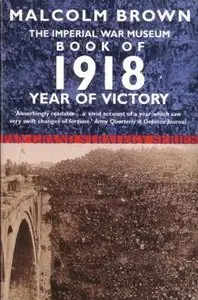Malcolm Brown, "The Imperial War Museum Book of 1918, Year of Victory"
Pan Books - Pan Grand Strategy Series | 1998 | ISBN 0330376721 | 395 pages | PDF | 202MB
1918 was probably the most dramatic and decisive year in British military history. Published on the eightieth anniversary of the 1918 Armistice, this book tells the story of a year during which the casualty lists on all sides were longer, the turns of fortune were most remarkable, and action was most intense. The author uses first-hand accounts of the participants of this dreadful conflict to tell of the horror of this conflict as seen through the eyes and experiences of the soldiers. With access to the Imperial War Museums archives he utilizes the reports, letters, diaries and interviews of the soldiers and civilians on both sides who fought during 1918. This is not only history but also flesh and blood. The accounts of some the people in this book are truly sad, they hit home and make plain that these were real people, individuals caught up in a war of massive scale and destruction.
This first account is by a 20-year-old Second Lieutenant during an assault on some German positions; "We passed on and quickly reached the objective, a line of trenches along the crest of slightly elevated ground. I jumped down into the German trench followed by a NCO and about eight men. The trench was deserted except for some bodies of dead Germans. Later, I noticed the sad manner of the death of one of these. Evidently a piece of shell had carried away the whole calf of his leg, baring it to the bone. He had dragged half of his body into a `cubby-hole' at the bottom of the trench side, there to die quietly, in the dark, his face hidden from the world. He was respected and grieved for, in death, by at least one enemy soldier." This was after this officer had seen a number of his friends cut down by German defensive fire and having a team of three men operating a Lewis gun in a shell hole with him killed. He picked up the gun and wiped the butt clean of blood and brain and passed it onto other soldiers to continue their advance (Page 211-215).
Another account is from Major F.J. Rice, 82nd Brigade, RFA. His account is about the death of a twenty-four year old Bombardier. He later received a package from the dead soldiers parents which he subsequently forwarded to his own mother with this covering letter; "Will you please put the enclosed away for me somewhere safe? I have always got nice letters back from parents whose sons have been killed in my battery but these seemed exceptionally grateful for my letter and sent me a photo of Bombardier Stone and a sort of memorial ribbon. He was badly wounded during the barrage we fired on Sept. 18th when we were shelled from 5-15 to 6-45 a.m. and we had to go on firing our guns all the time. We had ten casualties during that time (six killed). It was the worst hour and a half I have ever had." (Pages 271-272). The ribbon had a poem, which went on to say:
`How little we thought when we said good-bye,
We were parted for ever, and he was to die;
Oh, the grief that we feel words can never tell
For we could not be with him to bid him farewell;
But Christ will clasp the broken chain
Closer when we meet again.'
RapidShare



